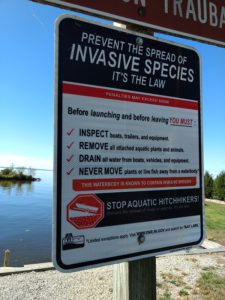Every month, we will put a spotlight on an aquatic invasive species (AIS) in a re-occurring monthly article. This month, Hydrilla! Check it out!
Hydrilla (Hydrilla verticillata) is a submerged rooted plant that grows vertically toward the water surface and, like Eurasian watermilfoil, can then grow  horizontally across the water surface. The leaves of the plant are arranged in whorls of 4 to 8 leaves along the stem. One of the ways to distinguish hydrilla from the common look-alike native plant common waterweed (Elodea canadensis) is to look for serrations along the edges of the leaves of hydrilla, as well as spines on the underside of the leaves. Common waterweed also typically has leaves in whorls of 3, while hydrilla has 4 or more leaves in a whorl. Hydrilla is native to India and Korea but was imported to the United States for use in aquariums. Wild populations of the plant were first seen in Florida following illegal aquarium r
horizontally across the water surface. The leaves of the plant are arranged in whorls of 4 to 8 leaves along the stem. One of the ways to distinguish hydrilla from the common look-alike native plant common waterweed (Elodea canadensis) is to look for serrations along the edges of the leaves of hydrilla, as well as spines on the underside of the leaves. Common waterweed also typically has leaves in whorls of 3, while hydrilla has 4 or more leaves in a whorl. Hydrilla is native to India and Korea but was imported to the United States for use in aquariums. Wild populations of the plant were first seen in Florida following illegal aquarium r eleases.
eleases.
Hydrilla prefers habitats with slow moving water in lakes, rivers, and other freshwater systems. Once it is established in a waterbody, pieces of the plant can break off from the mother plant and start a new plant somewhere else in the lake. Hydrilla can also be transported on boats, trailers, and other recreational equipment to new waterbodies. This invasive plant creates tubers that allows the plant to survive in the sediment of waterbodies during winter months. These tubers can survive out of water for several days and remain viable in lakes for up to four years.
Once established, hydrilla has been documented to cause significant disruptions in invaded waterbodies. Similar to Eurasian watermilfoil, hydrilla can grow faster than many native plants. Since hydrilla can grow horizontally across the water surface once it reaches the surface, it can form mats that can shade out native plants. The dense mats of hydrilla can interfere with boating, fishing, and other recreational activities on the water. Dense mats can also slow and change water flow in systems. Research on the impacts of hydrilla on native wildlife varies widely especially when comparing between lakes. As with most invasive species invasions, impacts will vary in intensity between different lakes. Hydrilla is classified as Prohibited in all counties in Wisconsin.
watermilfoil, hydrilla can grow faster than many native plants. Since hydrilla can grow horizontally across the water surface once it reaches the surface, it can form mats that can shade out native plants. The dense mats of hydrilla can interfere with boating, fishing, and other recreational activities on the water. Dense mats can also slow and change water flow in systems. Research on the impacts of hydrilla on native wildlife varies widely especially when comparing between lakes. As with most invasive species invasions, impacts will vary in intensity between different lakes. Hydrilla is classified as Prohibited in all counties in Wisconsin.
Want to help? HELP PREVENT THE SPREAD!
Every time you come off the water, make sure to follow these steps to stop the spread of faucet snails and other aquatic invasive species:
* Inspect boats, trailers, push poles, anchors, and other equipment for attached aquatic plants or animals.
* Remove all attached plants or animals
* Drain all water from boats, motors, livewells and other equipment
* Never move live fish away from a waterbody
* Never release aquarium plants or animals into your local waterways
Follow the Fox Wolf Watershed Alliance’s Winnebago Waterways Program on our Winnebago Waterways Facebook page or @WinnWaterways on Twitter! You can also sign-up for email updates at WinnebagoWaterways.org.
Questions? Comments? Contact Chris Acy, the AIS Coordinator for the Winnebago Waterways Program covering Fond du Lac, Calumet, Outagamie, and Brown and Winnebago Counties at (920) 460-3674 or chris@fwwa.org!
Winnebago Waterways is a Fox-Wolf Watershed Alliance program. The Fox-Wolf Watershed Alliance is an independent nonprofit organization that identifies and advocates effective policies and actions that protect, restore, and sustain water resources in the Fox-Wolf River Basin.
All text from this article is from the Winnebago Waterways AIS Strategic Plan. Sources can be found in the AIS Strategic Plan document.
Photo Credit: Paul Skawinski, Chris Acy
